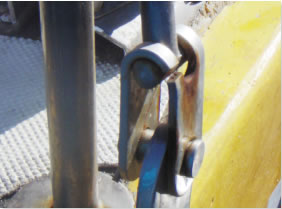
Photo byJohn Koon
This issue of Practical Sailor offers a wake-up call for owners of sailboats with rigs of an indeterminate age. But it also offers some hope. Over the years, weve published a variety of articles on the hidden risks of stainless-steel hardware-chainplates, tangs, toggles, clevis pins, etc.-important bits that keep a rig from coming down.
Probably the most detailed article on the topic was Technical Editor Ralph Naranjos critique of stainless steel (see Practical Sailor, February 2007 online). PS writer Patrick Childress concentrated on chainplate problems, which were the cause behind his mid-Pacific rig failure (see PS, December 2011 online). And various installments of Mailport and PS Advisor have featured readers experiences with failed hardware such as snap shackles and questions regarding rigging replacement and inspection schedules (see PS Advisor, January 2010 online).
One underlying moral of these stories is that stainless steel can fail without warning, a message that can leave a boat owner feeling helpless. Does this mean that our only resort is to replace anything that raises suspicion? The line between caution and paranoia becomes thin.
Fortunately, stainless-steel hardware has a long and mostly successful track record on boats, and the warning signs are often apparent. The trick is knowing what to look for when purchasing new gear, and how to inspect what we already own.
This month, renowned rigger and author Brion Toss puts a philosophical spin on spotting potential rig trouble. Although he is quick to say some problems can be traced to poor installation guidelines or shoddy manufacturing practices, he also reminds us that most rig problems are due to our own failure to educate ourselves on some of the basic principles of rig maintenance and inspection.
Boat owners can turn to a number of helpful resources that will guide them through an inspection to ensure that their rigs are up to snuff. If your boat was built in the last decade or so, chances are good that the boat manufacturer, or the spar company contracted to supply the rig, includes maintenance and inspection guidance.
For owners of older boats, owners associations can be a vital source. Websites or message boards dedicated to Taiwan builders such as Hans Christian, Ta Chiao (Formosa, Island Traders, CT) and Tayana, as well as many U.S.-built boats (like Childresss Valiant 40) have documented a range of chainplate problems and repairs in detail. Some of these problems are quite obvious, and will usually turn up in a routine visual inspection-others are not. (Google-search your boat model, for example Tayana 37 chainplate, to see what sort of rig issues your boat might have.)
The U.S. Coast Guard Marine Safety Alert, Sailboat Rigging Dangers, published in 2009 (www.mxak.org/uscg/uscg_pdfs/7-09a.pdf), has links to a couple of helpful websites. The alert, which was issued after a spate of rigging failures on Coast Guard-certified charter catamarans, should be required reading for every sailor, whether he has questions about the integrity of his rig or not.
If you have rig questions or failures to report, send them to practicalsailor@belvoirpubs.com. Thats why were here.




































